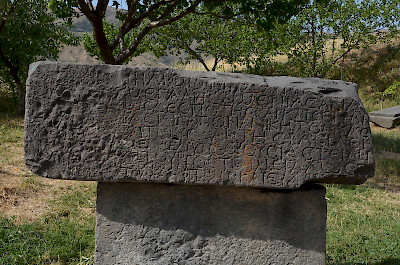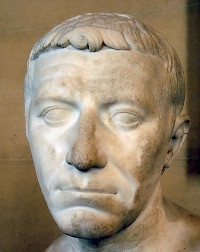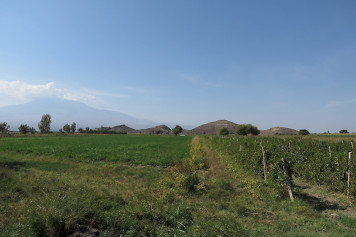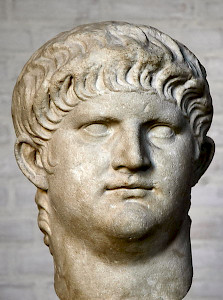Tiridates I
Tiridates I: king of Armenia (r. 51-59 and 63-c.80 CE), first effective ruler from the Arsacid dynasty.
The situation in Armenia

Armenia had been unstable for quite some time. The Artaxiad dynasty had lost control; in the first half of the first century CE, the Romans, who had the right to appoint Armenia's kings, had selected rulers from Media Atropatene (Ariobarzanes, Artavasdes III), Pontus (Artaxias III), Parthia (Arsaces), and finally from another branch of the Artaxiad family, which had ruled in the West-Caucasian kingdom of Iberia (Mithridates). Things turned into a disaster when in 51 CE, a nephew of Mithridates named Rhadamistus revolted against his uncle.
Two Accessions
At the same time, Vologases I became king in the Parthian Empire, succeeding his father Vonones II.note In the next year, 52 CE, the new Parthian ruler intervened in Armenia, occupied its capitals Artaxata and Tigranocerta, and made his younger brother Tiridates king of Armenia.note This was a direct violation of the Roman right to appoint the Armenian king., but Vologases may have thought that the old Roman emperor Claudius (r.41-54) would not respond to this provocation.
Indeed, Rome seems to have responded indirectly, by triggering a revolt in Media and Hyrcania, where Vologases' Vardanes II revolted.note The date of this insurrection is not precisely known but it would continue for several years and Vologases would (according to Tacitus) conduct "numerous campaigns".note To make Vologases' problems worse, the Armenian winter of 52/53 turned out to be severe and an epidemic broke out,note which forced Vologases to return home, leaving his brother Tiridates in Armenia, more or less unsupported.
Escalation

Because Tiridates was almost unsupported, the former ruler of Armenia, Rhadamistus, regained control. However, he had not much credit either, so in 55 CE, the Armenians expelled Rhadamistus him and invited Tiridates to come back.note This was not just an internal affair of the Armenians: it means that Rome had lost control of one of its vassal kingdoms.
Nero, who had become emperor in the preceding year, sent a good general, Gnaeus Domitius Corbulo, who was to reorganize the army in Galatia and Cappadocia,note which consisted of III Gallica and VI Ferrata, while the governor of Syria, Ummidius Quadratus, prepared two other legions, X Fretensis and XII Fulminata. Both Roman commanders sent messages to Vologases and were looking for a diplomatic settlement. The Parthian king, who had who still had to deal with his rebel son Vardanes II in Media and Hyrcania, complied and gave hostages (55 CE).note.

In the meantime, a new legion, IIII Scythica, arrived from the Danube, and the situation in Armenia got worse when Tiridates threatened pro-Roman Armenians. So the war, which both sides had tried to avert, broke out in 58.note After some initial fighting between the Armenians and the Roman forces, Corbulo proceeded to the Armenian capital Artaxata, forcing Tiridates to defend it, and risk a pitched battle. Indeed, the city fell,note followed by the other capital, Tigranocerta, in the next year.note Tiridates fled.
King Tigranes
The Romans, now in control of Armenia, blocked the advance of a Parthian army given to Tiridates by Vologases,note and installed a new, pro-Roman king, Tigranes VI, nicknamed "the Cappadocian", supported by a Roman garrison.note Several Armenian districts in the west were added to the kingdoms of Rome's vassals: to Aristobulus of Lesser Armenia, to Polemo of Pontus, and to Antiochus of Commagene. It is interesting that, the new king of Armenia, Tigranes, was another Herodian prince: Herod Agrippa had sent troops, Aristobulus had been made king of Lesser Armenia, and Tigranes was the third descendant of Herod the Great.
When Corbulo returned from Armenia, he learned that governor Ummidius of Syria had died,note and that he was to succeed him. This was a very prestigious appointment, a worthy reward for a general who had in 58 and 59 been spectacularly successful. Syria was not only a wealthy province, but also a large one, with the two annexes Cappadocia and Judaea ruled by procurators. Corbulo arrived in Antioch, the capital of his new province, in 60.
Tiridates Returns
The war was not over yet. The Romans continued to reinforce their army in Cappadocia with extra recruits and a new legion, V Macedonica, which arrived in 61. The knowledge that he would have Roman support gave the pro-Roman king of Armenia, Tigranes, the impression that he could do anything, and he raided the northern provinces of the Parthian Empire, especially Media Atropatene, which was governed by Vologases' brother Pacorus.note This forced Vologases, who wanted to keep out of the Armenian conflict because of the eastern revolt, to intervene. The king of Parthia convened a meeting of his nobility, declared that his brother Tigranes was the rightful king of Armenia, and marched against Rome after concluding an armistice in the east.note His HQs were at Nisibis.note
Corbulo reinforced the garrison in Armenia,note and the Parthians were unable to take Tigranocerta.note Corbulo now sent an envoy to Vologases, demanding that the Parthians retreated,note and an armistice was concluded: a Parthian embassy would go to Rome to negotiate a peace treaty. While this happened, the Roman commander Caesennius Paetus marched into a Parthian trap, found himself besieged at Rhandeia in the neighborhood of Arsamosata,note and surrendered.note
The Parthians believed they could now dictate the terms of the peace treaty. Vologases proposed that his brother Tiridates would visit Rome to do obeisance to Nero.note However, the Romans refused to come to terms: all out war with Vologases was preferable to an ignominious peace.note So, in the spring of 63 CE, Corbulo invaded Armenia again. He commanded four legions (III Gallica, V Macedonica, VI Ferrata, and the newly-arrived XV Apollinaris).note Vologases and Tiridates knew that this time, the war could no longer be won. On the other hand, Corbulo knew that it would be difficult to prolong the war, because fighting in the mountainous country was very hard. When Vologases sent envoys, Corbulo received them friendly.note
Rome

An armistice was agreed upon. The Roman negotiator was an Egyptian Jew named Tiberius Julius Alexander.note The Parthians conceded that in the future, the king of Armenia had to be appointed by the Roman emperor, and the Romans declared that they did not wish to prolong the war. The two parties agreed that Tiridates laid down his diadem and was to go to Rome, where he would receive the object again from Nero.note In 66, Tiridates did indeed visit Rome (still a ruin because of the great Fire). Cassius Dio writes
Tiridates presented himself in Rome, bringing with him not only his own sons but also those of Vologases, of Pacorus, and of Monobazus. Their progress all the way from the Euphrates was like a triumphal procession. Tiridates himself was at the height of his reputation by reason of his age, beauty, family, and intelligence; and his whole retinue of servants together with all his royal paraphernalia accompanied him. Three thousand Parthian horsemen and numerous Romans besides followed in his train. They were received by gaily decorated cities and by peoples who shouted many compliments.
… In Italy he was conveyed in a two-horse carriage sent by Nero, and met the emperor at Neapolis, which he reached by way of Picenum. He refused, however, to obey the order to lay aside his dagger when he approached the emperor, but fastened it to the scabbard with nails. Yet he knelt upon the ground, and with arms crossed called him master and did obeisance.
… After this event Nero took him up to Rome and set the diadem upon his head. The entire city had been decorated with lights and garlands, and great crowds of people were to be seen everywhere, the Forum, however, being especially full. The center was occupied by civilians, arranged according to rank, clad in white and carrying laurel branches; everywhere else were the soldiers, arrayed in shining armor, their weapons and standards flashing like the lightning. The very roof-tiles of all the buildings in the vicinity were completely hidden from view by the spectators who had climbed to the roofs.
Everything had been thus got ready during the night; and at daybreak Nero, wearing the triumphal garb and accompanied by the Senate and the Praetorians, entered the Forum. He ascended the rostra and seated himself upon a chair of state. Next Tiridates and his suite passed between lines of heavy-armed troops drawn up on either side, took their stand close to the rostra, and did obeisance to the emperor as they had done before.
… Nero bade him ascend by the approach which had been built in front of the rostra expressly for this occasion, and when Tiridates had been made to sit beneath his feet, he placed the diadem upon his head. At this, too, there were many shouts of all sorts.
… Such, then, was this occasion; and of course they had a costly banquet. Afterwards Nero publicly sang to the lyre, and also drove a chariot, clad in the costume of the Greens and wearing a charioteer's helmet. This made Tiridates disgusted with him; but he praised Corbulo, in whom he found only this one fault, that he would put up with such a master. Indeed, he made no concealment of his views even to Nero himself, but said to him one day: “Master, you have in Corbulo a good slave.” But this remark fell on uncomprehending ears.
In all other matters he flattered the emperor and ingratiated himself most skillfully, with the result that he received all kinds of gifts, said to have been worth 200,000,000 sesterces, and obtained permission to rebuild Artaxata.note
Back in Armenia
Artaxata was indeed rebuilt. Several years later, in 72, the Alans invaded Armenia and Tiridates fought without success.note
An inscription in Garni documents that Tiridates had the surname Helios, "the sun", and built "an impregnable fortress, to safeguard his kingdom, for his sister, the queen, in his eleventh regnal year". This would be 77 CE, counting from his second coronation by the emperor Nero, or 63 CE, counting from the moment he was made king of Armenia by his brother Vologases I, king of Parthia.
The elder Pliny, who may have been an eyewitness, calls Tiridates a magian, a specialist in Zoroastrian rituals.note